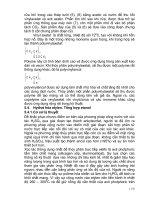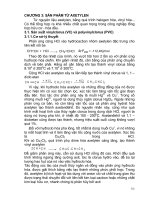Chapter1 Tổng hợp hữu cơ hóa dầu
Bạn đang xem bản rút gọn của tài liệu. Xem và tải ngay bản đầy đủ của tài liệu tại đây (947.49 KB, 34 trang )
PETROCHEMISTRY
Instructor: DAO THI KIM THOA
Department of Oil and Gas Processing, Faculty of
Chemical Engineering, University of Technology,
CHAPTER 1
Feddstocks for
petrochemistry
Feedstocks
Natural
Processing
Gas processing
Petroleum refining
Petrochemical processes
Crude oil
Products
Fuels
Chemicals
Gas processing-Petroleum refining-Petrochemical
processes
rimary feedstocks
Secondary feedstocks
Products
Natural gas
Gas
processing
Condensate
Gases
Associate gas Petroleum
Crude oil
refining
Fuels
Processe
s to
produce
seconary
feedstoc
ks
Reactio
ns
Petrochemical
processes
1 barrel
of crude
oil
19 gallons
naphtha
Gasoli
ne for
650
miles
ethyle
ne
PE
6 dust
bin or
276 m2
film for
green
house
160
yard
pipelin
e
Ethylen
e
glycol
21
Tshir
t
propylen
e
PP
4 beer
cover
or 30
fiber
roll
Acrylonitri
le
21
jumpers
C4
olefins
aromat
ics
fuel
elastom
er
Caprolacta
m
1 car
tires or
13
bicycle
tires
3 car
500
pairs of
sock
tube or
17
bicycle
tube
Catalytic Reforming produces high octane gasoline for today’s automobiles.
Gasoline and naphtha feedstocks are heated to 500 degrees Celsius and flow
through a series of fixed-bed catalytic reactors. Because the reactions which
produce higher octane compounds (aliphatic in this case) are endothermic
(absorb heat) additional heaters are installed between reactors to keep the
reactants at the proper temperature. The catalyst is a platinum (Pt) metal on an
alumina (Al2O3) base. While catalysts are never consumed in chemical
reactions, they can be fouled, making them less effective over time. The series of
reactors used in Catalytic Reforming are therefore designed to be disconnected,
and swiveled out of place, so the catalyst can be regenerated.
Alkylation is another process for producing high octane gasoline. The
reaction requires an acid catalyst (sulfuric acid, H2SO4 or hydrofluoric acid,
HF) at low temperatures (1-40 degrees Celsius) and low pressures (1-10
atmospheres). The acid composition is usually kept at about 50% making
the mixture very corrosive.
Catalytic Cracking takes long molecules and breaks them into much smaller
molecules. The cracking reaction is very endothermic, and requires a large
amount of heat. Another problem is that reaction quickly fouls the Silica (SiO2)
and alumina (Al2O3) catalyst by forming coke on its surface. However, by using
a fluidized bed to slowly carry the catalyst upwards, and then sending it to a
regenerator where the coke can be burned off, the catalyst is continuously
regenerated. This system has the additional benefit of using the large amounts
of heat liberated in the exothermic regeneration reaction to heat the cracking
reactor. The FCC system is a brilliant reaction scheme, which turns two
negatives (heating and fouling) into a positive, thereby making the process
extremely economical.
Hydroprocessing includes both hydrocracking and hydrotreating techniques.
Hydrotreating involves the addition of hydrogen atoms to molecules without
actually breaking the molecule into smaller pieces. Hydrotreating involves
temperatures of about 325 degrees Celsius and pressures of about 50
atmospheres. Many catalysts will work, including; nickel, palladium, platinum,
cobalt, and iron. Hydrocracking breaks longer molecules into smaller ones.
Hydrocracking involves temperatures over 350 degrees Celsius and pressures up
to 200 atmospheres. In both cases, very long residence times (about an hour) are
required because of the slow nature of the reactions.
Oil consumption per capita (darker colors represent more
consumption).
Oil producing
countries
Oil exports by
country
Oil imports by
country
Environmental
effects
U.S. Market for Catalysts by Applications, 2005 and 2010 ($ Millions)
RC-200N Petrochemical (Petroleum and Chemical) Catalysts - Updated Edition









